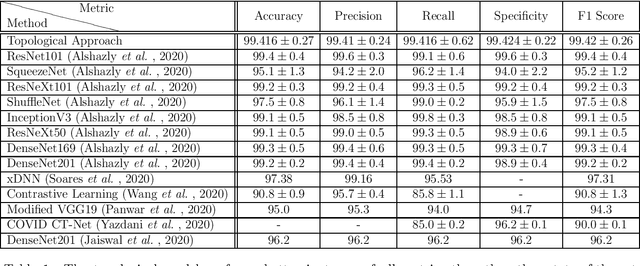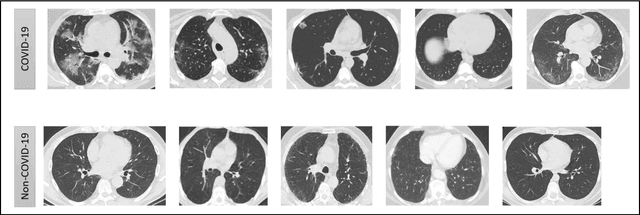Muhammad Imran Qureshi
Classification of COVID-19 via Homology of CT-SCAN
Feb 21, 2021



Abstract:In this worldwide spread of SARS-CoV-2 (COVID-19) infection, it is of utmost importance to detect the disease at an early stage especially in the hot spots of this epidemic. There are more than 110 Million infected cases on the globe, sofar. Due to its promptness and effective results computed tomography (CT)-scan image is preferred to the reverse-transcription polymerase chain reaction (RT-PCR). Early detection and isolation of the patient is the only possible way of controlling the spread of the disease. Automated analysis of CT-Scans can provide enormous support in this process. In this article, We propose a novel approach to detect SARS-CoV-2 using CT-scan images. Our method is based on a very intuitive and natural idea of analyzing shapes, an attempt to mimic a professional medic. We mainly trace SARS-CoV-2 features by quantifying their topological properties. We primarily use a tool called persistent homology, from Topological Data Analysis (TDA), to compute these topological properties. We train and test our model on the "SARS-CoV-2 CT-scan dataset" \citep{soares2020sars}, an open-source dataset, containing 2,481 CT-scans of normal and COVID-19 patients. Our model yielded an overall benchmark F1 score of $99.42\% $, accuracy $99.416\%$, precision $99.41\%$, and recall $99.42\%$. The TDA techniques have great potential that can be utilized for efficient and prompt detection of COVID-19. The immense potential of TDA may be exploited in clinics for rapid and safe detection of COVID-19 globally, in particular in the low and middle-income countries where RT-PCR labs and/or kits are in a serious crisis.
Learning deep multiresolution representations for pansharpening
Feb 16, 2021



Abstract:Retaining spatial characteristics of panchromatic image and spectral information of multispectral bands is a critical issue in pansharpening. This paper proposes a pyramid based deep fusion framework that preserves spectral and spatial characteristics at different scales. The spectral information is preserved by passing the corresponding low resolution multispectral image as residual component of the network at each scale. The spatial information is preserved by training the network at each scale with the high frequencies of panchromatic image alongside the corresponding low resolution multispectral image. The parameters of different networks are shared across the pyramid in order to add spatial details consistently across scales. The parameters are also shared across fusion layers within a network at a specific scale. Experiments suggest that the proposed architecture outperforms state of the art pansharpening models. The proposed model, code and dataset is publicly available at https://github.com/sohaibali01/deep_pyramid_fusion.
 Add to Chrome
Add to Chrome Add to Firefox
Add to Firefox Add to Edge
Add to Edge